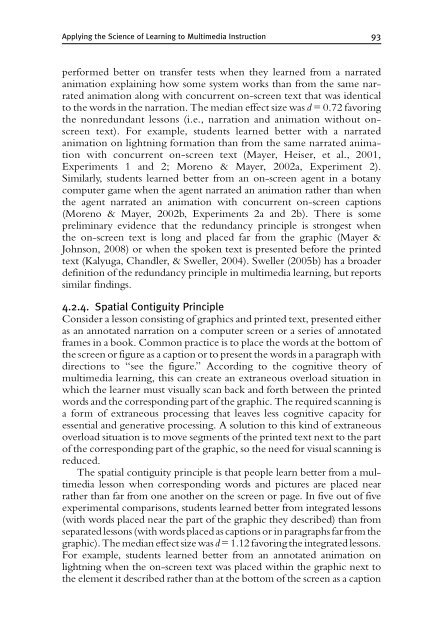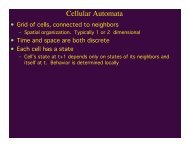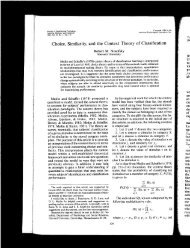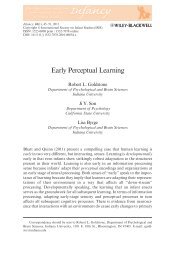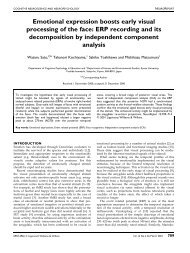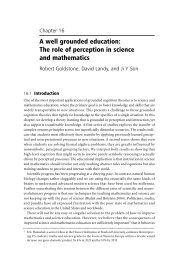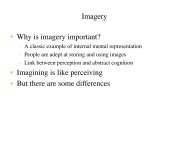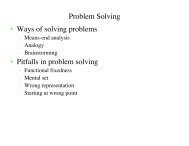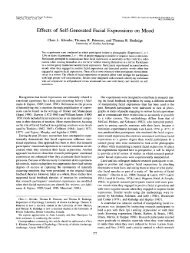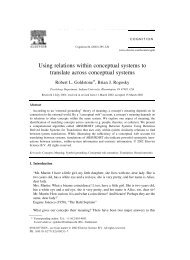the psychology of learning and motivation - Percepts and Concepts ...
the psychology of learning and motivation - Percepts and Concepts ...
the psychology of learning and motivation - Percepts and Concepts ...
You also want an ePaper? Increase the reach of your titles
YUMPU automatically turns print PDFs into web optimized ePapers that Google loves.
Applying <strong>the</strong> Science <strong>of</strong> Learning to Multimedia Instruction 93performed better on transfer tests when <strong>the</strong>y learned from a narratedanimation explaining how some system works than from <strong>the</strong> same narratedanimation along with concurrent on-screen text that was identicalto <strong>the</strong> words in <strong>the</strong> narration. The median effect size was d = 0.72 favoring<strong>the</strong> nonredundant lessons (i.e., narration <strong>and</strong> animation without onscreentext). For example, students learned better with a narratedanimation on lightning formation than from <strong>the</strong> same narrated animationwith concurrent on-screen text (Mayer, Heiser, et al., 2001,Experiments 1 <strong>and</strong> 2; Moreno & Mayer, 2002a, Experiment 2).Similarly, students learned better from an on-screen agent in a botanycomputer game when <strong>the</strong> agent narrated an animation ra<strong>the</strong>r than when<strong>the</strong> agent narrated an animation with concurrent on-screen captions(Moreno & Mayer, 2002b, Experiments 2a <strong>and</strong> 2b). There is somepreliminary evidence that <strong>the</strong> redundancy principle is strongest when<strong>the</strong> on-screen text is long <strong>and</strong> placed far from <strong>the</strong> graphic (Mayer &Johnson, 2008) or when <strong>the</strong> spoken text is presented before <strong>the</strong> printedtext (Kalyuga, Ch<strong>and</strong>ler, & Sweller, 2004). Sweller (2005b) has a broaderdefinition <strong>of</strong> <strong>the</strong> redundancy principle in multimedia <strong>learning</strong>, but reportssimilar findings.4.2.4. Spatial Contiguity PrincipleConsider a lesson consisting <strong>of</strong> graphics <strong>and</strong> printed text, presented ei<strong>the</strong>ras an annotated narration on a computer screen or a series <strong>of</strong> annotatedframes in a book. Common practice is to place <strong>the</strong> words at <strong>the</strong> bottom <strong>of</strong><strong>the</strong> screen or figure as a caption or to present <strong>the</strong> words in a paragraph withdirections to ‘‘see <strong>the</strong> figure.’’ According to <strong>the</strong> cognitive <strong>the</strong>ory <strong>of</strong>multimedia <strong>learning</strong>, this can create an extraneous overload situation inwhich <strong>the</strong> learner must visually scan back <strong>and</strong> forth between <strong>the</strong> printedwords <strong>and</strong> <strong>the</strong> corresponding part <strong>of</strong> <strong>the</strong> graphic. The required scanning isa form <strong>of</strong> extraneous processing that leaves less cognitive capacity foressential <strong>and</strong> generative processing. A solution to this kind <strong>of</strong> extraneousoverload situation is to move segments <strong>of</strong> <strong>the</strong> printed text next to <strong>the</strong> part<strong>of</strong> <strong>the</strong> corresponding part <strong>of</strong> <strong>the</strong> graphic, so <strong>the</strong> need for visual scanning isreduced.The spatial contiguity principle is that people learn better from a multimedialesson when corresponding words <strong>and</strong> pictures are placed nearra<strong>the</strong>r than far from one ano<strong>the</strong>r on <strong>the</strong> screen or page. In five out <strong>of</strong> fiveexperimental comparisons, students learned better from integrated lessons(with words placed near <strong>the</strong> part <strong>of</strong> <strong>the</strong> graphic <strong>the</strong>y described) than fromseparated lessons (with words placed as captions or in paragraphs far from <strong>the</strong>graphic). The median effect size was d = 1.12 favoring <strong>the</strong> integrated lessons.For example, students learned better from an annotated animation onlightning when <strong>the</strong> on-screen text was placed within <strong>the</strong> graphic next to<strong>the</strong> element it described ra<strong>the</strong>r than at <strong>the</strong> bottom <strong>of</strong> <strong>the</strong> screen as a caption


